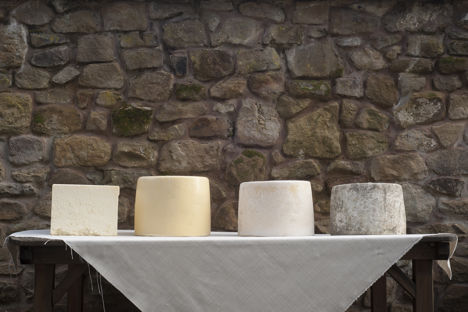
Butlers Farmhouse Cheeses: generations of flavour
In beautiful Lancashire, the Butlers family has been making cheese since the 1930s. Today, their cheeses – especially Blacksticks Blue – are championed as fantastic examples of farmhouse cheeses with a modern twist. We find out a little bit more about the family’s historic values and the secrets to creating award-winning cheese.
Butlers Farmhouse Cheeses: generations of flavour
In beautiful Lancashire, the Butlers family has been making cheese since the 1930s. Today, their cheeses – especially Blacksticks Blue – are championed as fantastic examples of farmhouse cheeses with a modern twist. We find out a little bit more about the family’s historic values and the secrets to creating award-winning cheese.
Lancashire is home to many different cheesemakers both big and small, but one of the most famous has to be Butlers Farmhouse Cheeses. Run by Matthew and Daniel Hall, who are the fourth generation of the Butlers family, you’ll find Butlers cheese in both supermarkets and delis, proving that artisan cheesemakers can grow without having to sacrifice their honest, down-to-earth values. All of the cheese is still made exclusively at Butlers’ family dairy using traditional handmade methods.
It’s impossible to make great cheese without great milk, and Butlers sources its milk from family and friends whose cows live off lush Lancashire grass. This means the milk is as fresh as can be and only travels a few miles before being pasteurised, made into one of Butlers’ cheeses and matured. It also helps that the team has four generations of cheesemaking experience to fall back on – many of the recipes for Butlers’ cheeses have been passed down from generation to generation. That means they’re still made, matured and graded by hand.
It’s clear that Butlers Farmhouse Cheeses puts provenance, innovation, authenticity (and, of course, taste) at the forefront of everything it does, ensuring every single cheese is perfect. Proven by winning a string of national and international awards, there are now three blues, four softs and six hards in the range. Here’s a little bit more information about their most popular varieties.
Blacksticks Blue
Blacksticks Blue was hailed the first contemporary British blue cheeses that proved the UK could create much more than Stilton. The rich milk comes from Lower Barker Farm just across the road from the dairy, which is then turned into wheels of deep orange and blue-veined cheese after around eight weeks of maturation. The resulting flavour is mild with a subtle tang – perfect for those who find other blue cheeses too intense – and the texture is so creamy it can be served on toast. It also melts very well, making it a popular choice for topping burgers or stirring through mash.
Kidderton Ash
An outstanding goats’ cheese handmade at Wilson Fields Farm, Kidderton Ash is log shaped and features a delicate creamy flavour. What sets it apart from other goats’ cheese is that it’s coated in a fine layer of (you guessed it) charcoal ash as it matures and develops its fuzzy white rind. This doesn’t just make it nice to look at – the flavour of the ash subtly comes through in the cheese. As Kidderton Ash matures it gets creamier, and its shape means it’s perfect for cutting into thin slices and placing on top of crackers. Do try incorporating it into dishes, too – it’s a fantastic addition to salads and makes a great alternative to brie.
Trotter Hill Tasty Lancashire
Trotter Hill is a fantastic example of just how important family values and heritage are to Butlers. It is a Tasty Lancashire cheese (one of the three territorial cheeses to come out of the county along with Crumbly and Creamy) but the recipe is what makes it special, being passed down over the years within the Butlers family. The result is a Lancashire that has just a slight acidic tang after up to twelve months maturing with an incredible open texture that’s ideal for making cheese on toast. Butlers also makes a Crumbly Lancashire, which is perfect crumbled over salads as an alternative to feta.
These three cheeses are the flagship varieties of Butlers, but there are plenty of others to keep an eye out for. There’s Ravens Oak, another soft cheese that sits nicely alongside Butlers’ other goat’s cheeses Inglewhite and Beacon Blue. Double Gloucester comes in the form of Goosnargh Gold, while Rothbury Red is made to an authentic Red Leicester recipe. Finally, Butlers’ new blue Stratford Blue is delicate and moreish, while their soft cow cheeses Button Mill (perfect for the cheeseboard) and Burland Bloom (a brie) are stunning examples of Britain’s cheese renaissance. All of them are equally at home on top of a cracker or used in cooking, and certainly worth seeking out. For budding cheesemakers across the UK, Butlers is a business to look up to – after all, they’ve been growing non-stop for over eighty years.


